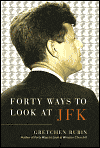40 Ways to Look at JFK

When I plunged into the research on John F. Kennedy’s life, an uncomfortable truth confronted me: Kennedy’s portrait could be drawn in innumerable ways, all “true.” I was struck to see his biographers reach different conclusions from the same facts.
Some JFK biographers depict Kennedy as a great leader who inspired Americans with his compelling vision of a better country; others show him to be merely a gifted entertainer who distracted Americans with glamorous photographs and witty one-liners. Once I had command of the material about Kennedy’s life, I amused myself by tracing how each account exaggerated certain details, and slid over others, to support its conclusions.
These machinations reminded me of what I’d seen while clerking for Justice Sandra Day O’Connor at the Supreme Court. There, I’d often had the jarring experience of reading an absolutely convincing legal brief – and then reading an equally compelling opposing brief. Each side could marshal facts, quotes, and precedent to support opposite conclusions.
In the same way, after reading a good biography, you think you really understand its subject. But if you read several biographies about the same person, you detect the subtle devices of biographers and the limits of each point of view.
Facts can be assembled to create very different portraits. Take me, as an example. I could emphasize that at Yale Law School, I was editor-in-chief of the Yale Law Journal, won a writing prize, and met my future husband. I could mention that my first book received a starred review from Publishers Weekly and was optioned by a Hollywood producer, and that my second book Forty Ways to Look at Winston Churchill was a best-seller. I clerked for Supreme Court Justice Sandra Day O’Connor, was a chief adviser to FCC Chairman Reed Hundt, for years taught a seminar at Yale Law School and Yale School of Management, and my father-in-law is Robert Rubin, the former Treasury Secretary.
Or I could paint a very different picture of myself. I could emphasize that after law school, I worked only briefly as a lawyer, and then, despite the huge investment of money and effort, abandoned that field to turn my efforts to writing – at a point when I’d already written two dreadful novels I’d abandoned. I failed a national math exam, wasn’t involved in a single extracurricular activity in college, and didn’t have my first boyfriend until I was twenty-three years old. I’m legally blind, I’m left-handed, completely uncoordinated, a constant hair-twister, and afraid to drive. All of these facts are accurate. But they leave very different impressions.
As I considered how best to portray Kennedy, I wanted to find a way to make sense of the conflicting evidence as well as to establish what I thought important. Instead of arguing only the case that supported my conclusion, I resolved to show the counter-arguments as well. So while many JFK biographies disguise or reconcile conflicting views, I highlight them. I present Kennedy in all his virtues and flaws; his warmth and his cool detachment; his soaring rhetoric and his sordid assignations.
To capture this complexity, I elected to portray Kennedy by looking at him from forty angles. And so Forty Ways to Look at JFK asks the reader to look at Kennedy in multiple ways and, by doing so, to consider the problems inherent in biography.
The book is divided into forty chapters, each creating a different picture of JFK. Because form is as influential as substance, I exploit various structures, some quite unexpected (one chapter is a timeline, one is a question-and-answer, one consists of nothing but photographs) to portray my subject. And rather than try to reconcile conflicting views, I’ve kept them distinct, so readers may decide for themselves what picture of Kennedy emerges.
I point to evidence that shows that Kennedy planned to pull out of Vietnam after the 1964 election – and to evidence that shows that Kennedy had no intention of retreating. I emphasize that Kennedy was proud of his wife and devoted to his children – and I expose Kennedy’s naked White House swimming pool parties, his affair with an intern, his dalliances with prostitutes and suspected spies.
By approaching my subject in this way, I’m able to write a short book about a very large subject. Rather than detail the facts of Kennedy’s life, as most biographies do – which can make them so long and crowded that a reader loses the big picture – I focus on the essential questions that surround Kennedy. So often, with the weight of their detail, encyclopedic biographies leave readers with a fuzzy sense of a subject’s life. I hope that my approach will allow readers to understand my subject with speed and clarity.
I also use this approach to attempt to answer the central puzzle: what made Kennedy, Kennedy? Why, after a presidency that took place decades ago, and lasted only two years, ten months, and two days, does he still fascinate the public? His fortune, his wit, his rapport with the press, his wife, his tragic death…I examine all these factors, and more.
This fragmented approach seemed the most economical and also the most exciting way of pulling out the essential from the overwhelming material about Kennedy’s life. Although the facts may seem contradictory, readers must consider both the positive and negative aspects of Kennedy’s life and character if they are to judge him – and without history’s judgment, his life lacks significance.
I hope that this biography – as unconventional as it is – will help others to catch a glimpse of Kennedy’s extraordinary life, and to consider, as well, how little we can know anyone, and how impossible is the task of summing up.
